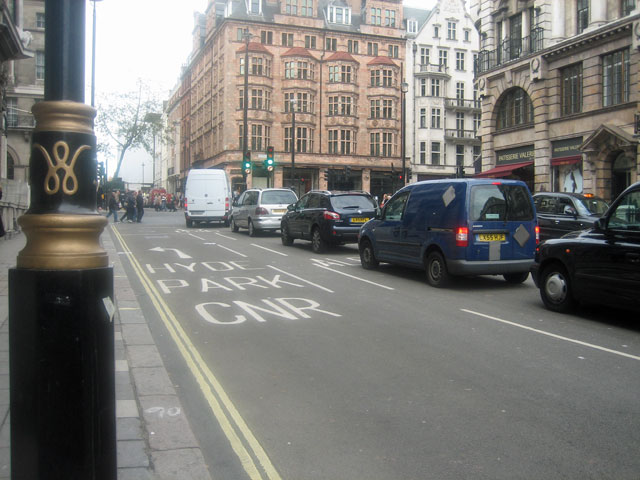
Piccadilly, Pall Mall and St James' Street in central London have recently changed from one-way to two-way
Peter Murray, Head of the New London Architecture Centre and a supporter of the two-way movement is reported as saying: “One-way streets reflect the dominance of the car and the failed go-faster policies of the traffic engineers. As we begin to realise that walking and cycling should be the dominant forms of transport, the one-way street should be consigned to the dustbin of history.”
In March 2009 Westminster Council were planning to provide a southbound contra-flow cycling facility on St James' Street but this has been superseded by the two-way scheme
In the new scheme the south-bound cycle route down Old Bond Street doesn't join to southbound St James' Street and cyclists must turn left onto Piccadilly, right down Duke Street and then left into Jermyn Street in order to reach it. This seems contrary to the previous intention to improve cycling facilities
An advanced stop line (ASL) has been provided at the north end of St James' Street with a "feeder" cycle lane in between the two lanes of traffic leading into it. In my view, this junction is extremely dangerous for cyclist.
The junction has a fast left filter and traffic ignores the feeder lane. Any cyclist waiting to cross Piccadilly at the front of the feeder lane risks being hit from behind by traffic

The feeder lane does not appear to meet TFL design standards. It's 1m wide when it should be a minimum of 1.5m wide. It has no cycle markings or colouring when it should have both of these. The ASL box should also have a coloured surface
The relevant section from the TFL London Cycling Design Standards document http://www.tfl.gov.uk/assets/downloads/businessandpartners/lcds_chapter5.pdf is
5.3.14 A 2.0m wide cycle lane (minimum width 1.5m) should be provided where lanes are not adjacent to kerbs and this should have coloured surfacing.
5.3.19 The following should be considered when designing ASLs:
• A large cycle Diagram 1057 symbol 1.7m wide by 2.75m deep should be provided in the cycle reservoir. Where the reservoir is greater than 2 lanes wide more than one Diagram 1057 symbol should be used (this presently requires DfT authorisation).
• Colour surfacing should be used in ASL reservoirs to increase awareness of the facility by motorists.
• The length of the lead-in cycle lane should be maximised and where possible extend beyond the maximum peak period vehicle queue-length, if not for the full length of the link. Diagram 1057 cycle symbol markings at 10 - 20m centres should be provided close to the junction.
I've had a email dialogue with Westminster Council Piccadilly Two Way team asking why the improvements that were planned for southbound cycling have not been made and drawing their attention to how the northbound cycling provision does not meet TFL standards. They seem to have stopped replying to me now.